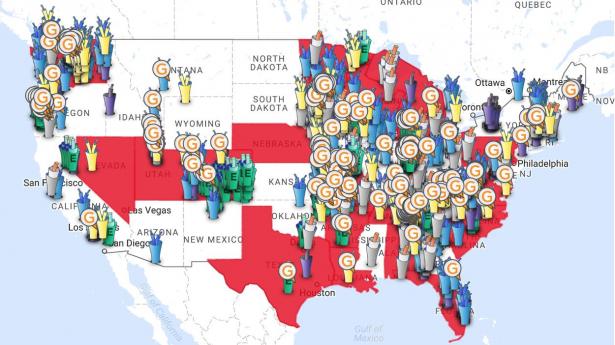More communities than ever are embracing building their own broadband networks as an alternative to the Comcast status quo.
According to a freshly updated map of community-owned networks, more than 750 communities across the United States have embraced operating their own broadband network, are served by local rural electric cooperatives, or have made at least some portion of a local fiber network publicly available. The map was created by the Institute for Local Self-Reliance, a nonprofit that advocates for local economies.
Many of these laws even bar communities from striking public/private partnerships with companies like Google Fiber, even in instances where no private ISP is willing to provide service.
"Municipal and cooperative networks were essential in driving electrification and we are seeing the same dynamic with the expansion of high-quality Internet access"
The Institute's latest update indicates that there’s now 55 municipal networks serving 108 communities with a publicly owned fiber-to-the-home internet network. 76 communities now offer access to a locally owned cable network reaching most or all of the community, and more than 258 communities are now served by a rural electric cooperative.
Many more communities could expand their local offerings according to the group’s data. 197 communities already have some publicly owned fiber service available to parts of the community, while more than 120 communities have publicly-owned dark (unused) fiber available for use by local residences and local area businesses.
The group’s map also highlights which states have erected legislative barriers to hamper these local efforts and explains what these laws actually do.
With the Trump administration’s recent assault on both net neutrality and broadband privacy protections, interest in local broadband as an alternative to incumbent providers has only grown.
"Evidence from other cities suggests that a real choice in broadband services could reduce Comcast's revenues by millions of dollars per month"
“What this update shows is that, despite federal hostility to community network solutions, more communities are investing than ever,” Christopher Mitchell, director of the Community Broadband Networks initiative at the ILSR, said in a statement. “Municipal and cooperative networks were essential in driving electrification and we are seeing the same dynamic with the expansion of high-quality Internet access.”
Much like net neutrality, ISP lobbyists and policy folks have long-framed municipal broadband as a partisan debate in the hopes of derailing such efforts. But the group’s data shows that these networks are most frequently popping up in Conservative areas and have broad, bipartisan support. Our desire for better broadband, and our collective disdain for Comcast, tends to be one of the few things capable of bridging the partisan divide.
As we recently saw in Fort Collins, Colorado, ISPs are frequently willing to spend plenty of money in attempts to malign and denigrate community broadband at every opportunity. They’ve long been afraid of this trend taking off and threatening the cash cow that is the overall lack of competition in countless markets nationwide.
"Evidence from other cities suggests that a real choice in broadband services could reduce Comcast's revenues by millions of dollars per month," the group stated in a policy brief late last year. "Competition in Fort Collins would cost Comcast between $5.4 million and $22.8 million per year. In Seattle, robust competition would cost between $20 million and $84 million per year."
ISPs eager to nip these efforts in the bud could offer better, cheaper broadband. Instead, they’ve chose to spend that money lobbying for state laws prohibiting your town or city from even exploring the option.


Spread the word